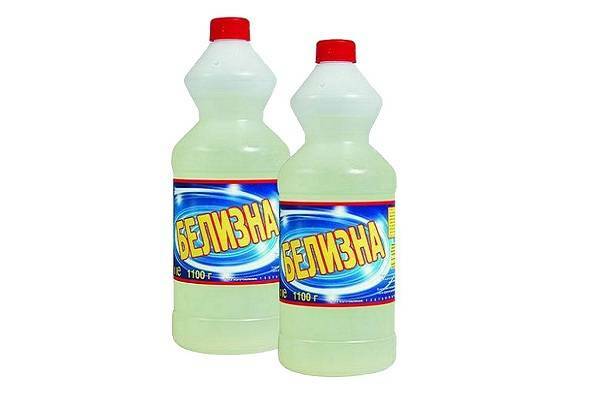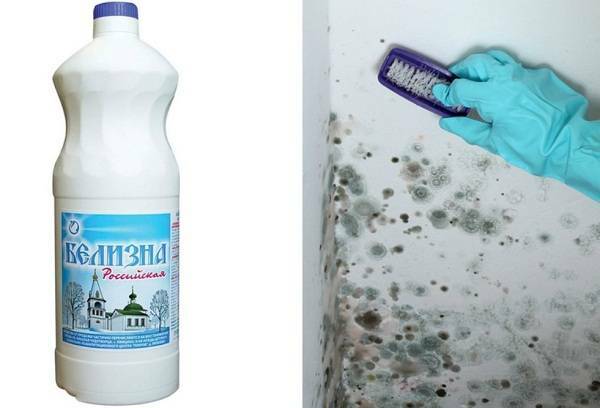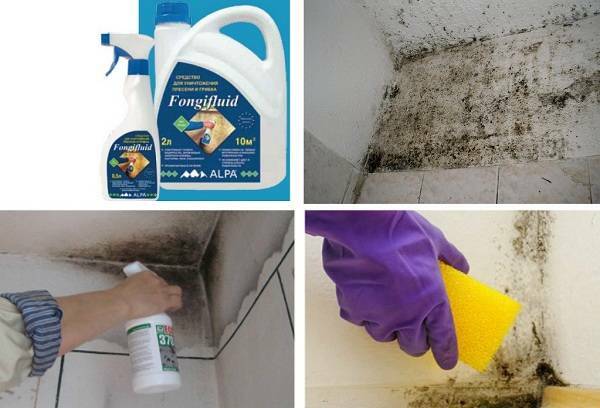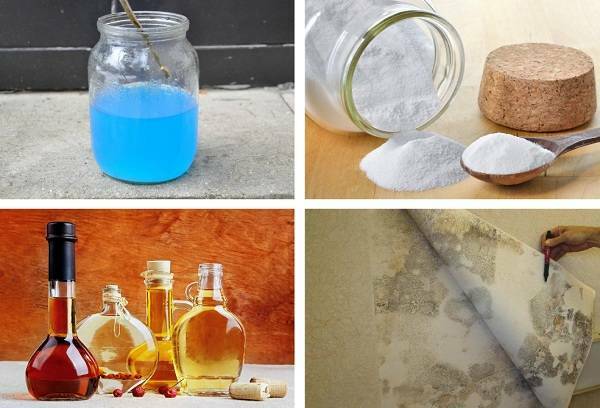Contents:
- Usage rules Whiteness
- Features of severe lesions treatment
- Other effective folk remedies for mold control
If for some reason the use of fungicides( special means for combating mold) is impossible, it is worth trying proven folk approaches. The whiteness against the fungus on the walls has been used for a long time and managed to prove itself only from the best side. However, when using the product, you need to remember that you need not only to get rid of mold, but also not to harm people living in the apartment. In addition to the chlorine-containing solution, other folk remedies that are equally effective can be used at home.

Application rules for whiteness
When declaring war on mold, it is necessary first of all to establish the cause of its appearance. If you simply get rid of the traces of parasitizing the fungus by regular cleaning, it will not give the desired result. Even the most effective means, whose action is directed against the active reproduction of a specific microorganism, is temporary. Only after it becomes clear why multicolored colonies appear on the walls, and appropriate preventive measures are taken, can one begin to eliminate mold traces and the results of its life activity.
In case the fungus colonies cover only small areas and have not yet had time to influence the quality of the plaster, wallpaper and other raw materials, we act according to the following scheme:
- Apply whiteness directly to the affected areas. This can be done with a brush, sponge, spray. Pre-dilute the composition is not necessary, the concentrated product will give the best effect.

Tip: If you have to deal with colored wallpaper, it's best to first check how the Whiteness affects their color. Generally, chlorine bleach is better used for the treatment of plasters, tiles, wooden and stone surfaces. For fabric and paper, it's better to pick something less aggressive.
- Leave the treated areas on the walls to dry independently without using a hair dryer or other sources of artificial heat to speed up the process.
- As the chlorine dries, mold spots will lighten and then completely disappear, but this does not mean that the fight against the fungal colonies is complete.
- Next, take a dense brush and begin to carry out mechanical processing of the affected areas, until you can not get rid of the slightest trace of the parasite.
It is worth considering that whiteness has a sharp smell and is aggressive towards surrounding objects. Therefore, the procedure for removing mold on walls, ceiling and furniture should be done in good ventilation and only with rubber gloves.

Features of processing serious lesions
If the situation is such that you do not just have to deal with mold traces on the walls, and the material has lost its original texture and crumbles, then the approach should be more radical:
- Infected raw materials( plaster, paint, wallpaper, whitewash)must be removed to a clean layer. We process not only areas with traces of the fungus, but also go a little on a clean product.
- Next, carefully dry the problem area. For this purpose, it is best to use heaters with an open spiral, burning oxygen and reducing the humidity level of the air.
- On the prepared surface, we apply a composition against reproduction of mold. It may be a folk remedy, but it is better to use an industrial fungicide, which can be found in many construction shops.

- In the next step, dry the treated areas again. At the same time, the means used to combat mold should not be washed off, it should just stay on the walls and absorb well.
- After the processing is completed, we begin to restore the attractiveness of the walls. If whitewash, putty or paint is used, then you can add a little disinfectant and in the composition, this will ensure a reliable prevention of the return of mold.
Approximately the same actions are shown when working with a tree. True, here with the cleaning of the surface the situation will be more complicated. If you do not cut the affected areas, the problem will soon return.
Other effective folk remedies for mold control
If it is not possible to use whiteness or a ready-made solution to eliminate the fungus, one of the following options can be considered:
- Copper sulfate. For 10 liters of water we take 100 g of copper sulfate and prepare the solution. With the resulting composition we process the surface, as well as chlorine bleach. It should be noted that this option can leave stains on the walls, so it is best to use it before carrying out cosmetic repairs.

- Vinegar. Solid surfaces( stone, tile) can be treated with a solution of undiluted table vinegar. You just need to remember that this product begins to smell even more if it is heated. Therefore, it is not recommended to dry the walls treated with artificial heat sources.
- Soda with washing powder. This mixture will allow to get rid of mold in the spaces between the tiles. In a glass of hot water, add a tablespoon of baking soda and 2.5 tablespoons of conventional washing powder. We take a brush, we dip into the composition and thoroughly clean all the problem areas. After that, the product should not be washed off, the main thing is to dry the room well.
If surface or deep processing yielded not very pronounced positive results, this indicates the penetration of mold into the structure of the material. Only cosmetic repair, which implies a complete replacement of the wall covering, will help here.
